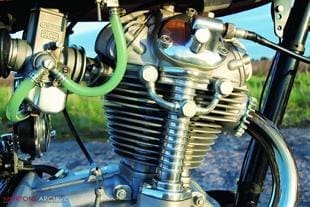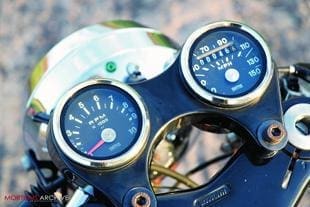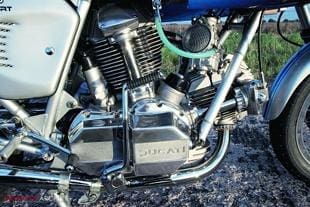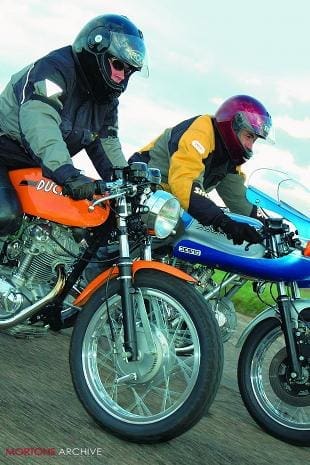
If anything can get the heart racing and the blood pounding it’s a big, lusty Italian motorcycle. And they don’t come much lustier than the Ducati 900SS, possibly the ultimate road version of Ducati’s legendary air-cooled L-twin of the 70s. When Nick told me he was rebuilding one to match his wife’s 250 Desmo, I expressed a passing interest in taking a look at them once the 900 was finished, but when I saw the bikes for the first time in the paddock at East Kirkby my heart stopped. For these were no mere rebuilds, they were possibly the tidiest examples of the legendary motorcycles I had ever seen.
Nick’s apparently casual approach to bike restoration disguises the skill and dedication that make his bikes something very special indeed, and he tends to shy away from the publicity that comes from exhibiting at shows. But, despite his protestations, I simply had to get these two bikes in front of a camera, and a few days later I had cajoled him and his wife Tracy to meet up with me and photographer for a test ride and full photo shoot.
 It was only after taking the pictures that Nick, in typical style, casually remarked that the keys were in both bikes if I’d like to try them out. Oh, it’s a tough life being a magazine editor sometimes, though I have to admit to a touch of nervousness as I straddled the big Ducati for the first time for, in all my years of tootling around on other people’s motorcycles, this was the first time I’d ever ridden a real, honest to goodness 900SS.
It was only after taking the pictures that Nick, in typical style, casually remarked that the keys were in both bikes if I’d like to try them out. Oh, it’s a tough life being a magazine editor sometimes, though I have to admit to a touch of nervousness as I straddled the big Ducati for the first time for, in all my years of tootling around on other people’s motorcycles, this was the first time I’d ever ridden a real, honest to goodness 900SS.
But the first hurdle was to get the thing started. Modern Ducatis are sweet, user-friendly bikes, and are designed to be easily manageable by those migrating from other brands. However, back in the mid-70s the factory were much less compromising, and the 900SS not only has no electric starter, but also a distinct lack of side stand. This means you can either sidekick the bike before clambering on and rocking it off the stand, or get astride first and, without the security of a propstand to support the bike, risk leaping in the air to get a good swing on the kick-start with all the imagined perils of going over sideways and landing in a heap with a bashed and scraped £10,000 motorcycle. It’s a rite of passage, and the first challenge thrown up by this totally uncompromising motorcycle. “Come and have a ride if you think you’re hard enough,” it mutters beneath its breath.
Roared into life
Taking a deep breath, I swung on the kick-start and the big beast roared into life. Praise the Lord and all his angels. Now all I had to do was get on board and get the bike off its stand without losing my cool. But even then I wasn’t yet home and dry. “There’s not much steering lock,” shouted Nick into my helmet, as I realised with some dismay that the bike would need a six- or eight-point turn to manoeuvre it round in the road.
Safer, then, to set off in the direction we were already facing. Clutch in, a slight clunk into first gear, and easing the clutch out produced a deep rumble from the pipes as the surrounding countryside started to go gently backwards. Clicking up a gear, the scenery began to disappear faster, and by top gear the surrounding bushes were a blur as the big engine gathered pace effortlessly.
 Introduced in 1975, the Ducati 900SS was a direct replacement for the factory’s 750SS racer, itself developed directly from Paul Smart’s Imola-winning 1972 bike. As such it was the closest thing the average punter of the time could buy to a true production racer, and lots of them ended up on the racetrack.
Introduced in 1975, the Ducati 900SS was a direct replacement for the factory’s 750SS racer, itself developed directly from Paul Smart’s Imola-winning 1972 bike. As such it was the closest thing the average punter of the time could buy to a true production racer, and lots of them ended up on the racetrack.
The engine first appeared in September 1970 in the 750GT. Designed by Fabio Taglioni, the 90-degree air-cooled V-twin was arranged with the front cylinder at a shallow angle to the ground, resulting in lower centre of gravity and better cooling for the rear cylinder. Because of its orientation in the frame, the factory always preferred the term ‘L-twin’, a term they still use on current models. But what really set the Ducati apart was the ‘Desmo’ valve operating system, common to both singles and L-twins. Short for ‘Desmodromic’ (a term invented by Fablioni), the system uses a set of rocker arms to both open and close each valve, dispensing with conventional valve springs and removing the ceiling on rpm imposed by valve float. Mercedes tried the system on their Grand Prix cars in the 50s, and it made its debut in motorcycling with the 1968 Ducati Mark 3 single.
860GT engine
Based on the roadster 860GT engine, the 900SS shares the 860’s squared-off engine covers, which makes it easily distinguishable from the earlier 750. Nick’s bike is a 1976 model; the first year to feature a left foot gear-change.
Riding a big air-cooled Ducati is totally unlike any other biking experience. There’s a sense of stillness and calm on board that puts you at the very centre of things. Wind it on, and the experience is like living inside the eye of the hurricane as the controls seem to make the world rush past at ever increasing speed. All this, and I’d only ridden the bike for a quarter-of-a-mile! Time to turn it around for the run back, and face the demons of paddling the huge bike around in the middle of the road without falling over or allowing the engine to stall. By the time I got back to Nick and Tracy, I was beginning to feel almost confident, and was buzzing on adrenaline. “Yeah, it’s quite nice,” I remarked in what I hoped was a casual-sounding tone, then surprised myself by managing to step off the bike and rock it on the centre stand at the first attempt. How cool is that? “Want to try the little one?” asked Nick.
 Now, I can admit to having ridden a smaller Ducati single before. Back in nineteen-seventy-ahem my mate Steve bought a 250 Desmo in preference to a new T150 Trident, a decision that shocked us all at the time. I remember belting that little bike round the Dales one glorious Sunday afternoon before Steve pulled over and insisted we swap back to our own bikes again, as I was having all the fun. But that was years ago, and surely the little 250 would feel like a weedy tiddler after the mighty 900SS. It was certainly a lot smaller and lighter – as you’d expect.
Now, I can admit to having ridden a smaller Ducati single before. Back in nineteen-seventy-ahem my mate Steve bought a 250 Desmo in preference to a new T150 Trident, a decision that shocked us all at the time. I remember belting that little bike round the Dales one glorious Sunday afternoon before Steve pulled over and insisted we swap back to our own bikes again, as I was having all the fun. But that was years ago, and surely the little 250 would feel like a weedy tiddler after the mighty 900SS. It was certainly a lot smaller and lighter – as you’d expect.
Despite Nick’s concerns (and the awkward left hand kick-starter) it started up on my first kick, and I folded my 6ft 4in frame carefully to wedge into the riding position dictated by the clip-on bars and high, rear-set pegs. Under way, the littlest Desmo was surprisingly responsive, with a free revving, punchy engine, but it wasn’t until later that evening that Nick was to show me what the 250 was really capable of.
The baby of the Desmo family, the 250 owes its origins to Ducati singles from the early 60s, particularly the 1965 Mach 1. A redesign for 1966 saw a switch to wider crankcase castings and Desmo valve operation offered as an option. Tracy’s bike is a 1974 model, one of the last, which shared showroom space with an almost identical 450 version. The bikes were expensive in their day but recognised, even then, as design classics in their distinctive yellow paint schemes.
Wrapping up the photoshoot, we were packing up the camera gear when Nick suggested that he and I take the two bikes out for a run. “You take the 900,” he said. “I fancy a do on the 250 and I’ll take you round some of the local back roads and twisties.”
 Gulp. Unable to resist the lure of the SS, I suited up, fired up the motor once more and levered the big bike off its stand, then rolled off after Nick’s rapidly disappearing form on the 250. It soon became apparent that Nick not only knew the roads like the back of his hand, he could also make that little 250 Desmo fly; and within a few short miles I was working hard on the 900 to keep up. This was my first real chance to evaluate the bike’s handling, and if you’ve read about the long wheelbase and ponderous steering, I can tell you it’s all true. But what that translates to on the road is a stability rarely seen on modern bikes which, coupled with the confident, unhurried feel from the engine, makes for a bike that will make rapid progress without any fuss and with supreme competence.
Gulp. Unable to resist the lure of the SS, I suited up, fired up the motor once more and levered the big bike off its stand, then rolled off after Nick’s rapidly disappearing form on the 250. It soon became apparent that Nick not only knew the roads like the back of his hand, he could also make that little 250 Desmo fly; and within a few short miles I was working hard on the 900 to keep up. This was my first real chance to evaluate the bike’s handling, and if you’ve read about the long wheelbase and ponderous steering, I can tell you it’s all true. But what that translates to on the road is a stability rarely seen on modern bikes which, coupled with the confident, unhurried feel from the engine, makes for a bike that will make rapid progress without any fuss and with supreme competence.
It’s a big bike, even for someone of my size, which means you can stretch out behind that surprisingly accommodating fairing and focus on honing the nuances of gear-changing and steering input. As each mile rolls by, the bike takes you more into its confidence, like a posh senorina admitting you to her inner boudoir, and the world of lesser mortals is left behind in a blur. Reaching our destination and giving the keys back to Nick, I felt a little like an addict being separated from their fix. Now I understand the lure of the 900SS, and that night I think I came close to falling in love.
? Related articles: Desmodromics



